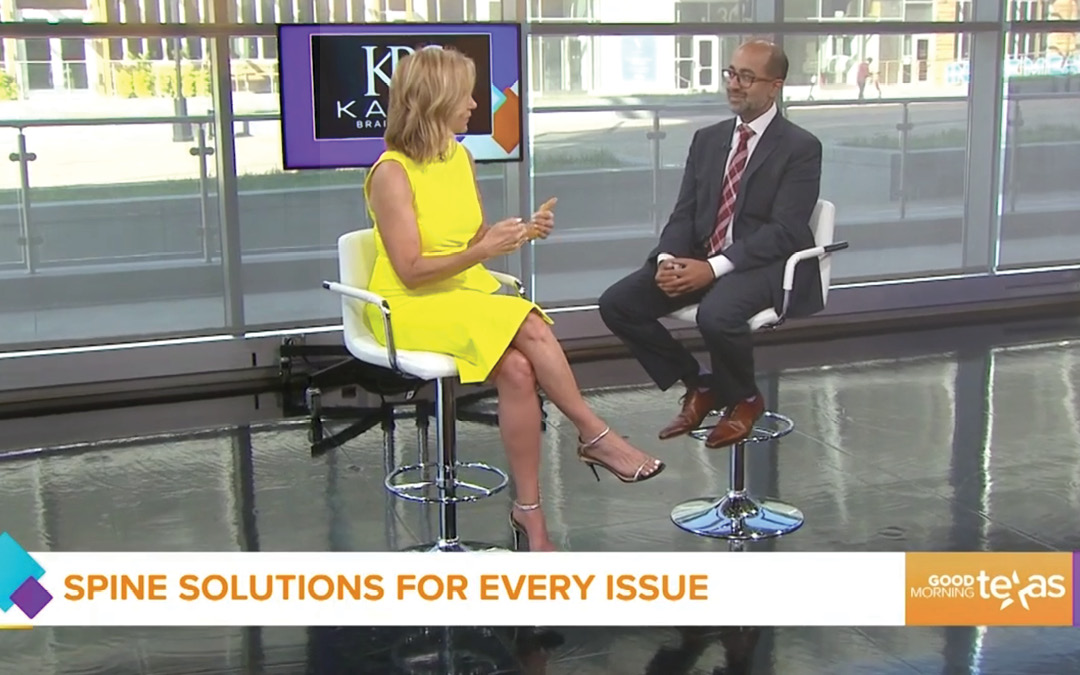If you’re in Dallas/Fort Worth and you don’t know Good Morning Texas, where have you been? A staple in Texas morning news for over 25 years, Good Morning Texas is the place to find out what’s happening all around the area. Dr. Kalra was honored to talk about spine health and new technologies in a recent segment. His passion for helping people live free from chronic neck and back pain extends to educating the community every chance he gets, so he jumped at the opportunity to appear on GMT
Watch the Appearance Below
Or, Read Dr. Kalra’s Interview with GMT’s Host Jane McGarry
Jane: If you suffer from back or neck pain, you know how debilitating it can be, you also know how intimidating it is to get help. With so many options, it’s often difficult to know where to go to get relief. Dr. Ricky Kalra, of Kalra Brain & Spine, wants to give you the life-changing care you need with the least invasive options for your condition. Good morning, Dr. Kalra.
Dr. Kalra: Good morning.
Jane: Nice to have you here. As a neurosurgeon, what makes you an expert in spine health?
Dr. Kalra: Neurosurgeons spend almost eight years training how to operate on the spine, the brain, the nerves and the vertebral column; compare that to some of the other experts: chiropractors, physical therapists, orthopedic spine surgeons and even pain doctors; most of them get 24 months of training.
I spent an extra six months after my training in Germany, just trying to learn the new technologies coming out of Europe. One of the interesting parts recently is that my practice has completely changed. Because of the new technologies coming out, some of these other experts are now starting to send some patients to me just because they want their patients to get the least invasive, newer technologies coming out of Europe.
Jane: So, what brought you to the Dallas/Fort Worth area?
Dr. Kalra: I grew up in Plano; I moved to Plano when I was 14. I love the city. I love the neighbors, the people. I went to high school there. I went down to Houston to Rice University and wanted to move back, so when I met my wife in residency, I told her we are moving back to Plano, and sure enough, I live two miles down the road from where I grew up.
Jane: Oh, wow! That’s great! We love to hear that you love DFW. Tell us more about the spine treatments that you offer, because this is really debilitating for people.
Dr. Kalra: And that’s what I tell patients when they come to see me. I say, “Okay, tell me why you are here,” because it’s often not a pinched nerve or a disc they are talking about. They say simple things like, “I can’t throw the ball to my son,” and so we start with the basics of what they want, what they want to get back, then we try to design a multimodality treatment.
It can be physical therapy, medications, lifestyle modifications and sometimes even surgery, but the idea of surgery has changed. The surgery we think of is the one from the TV shows and those aren’t real anymore. We’re using small incisions, minimally invasive techniques, like an artificial cervical disc, and we’re seeing patients go back to work very quickly.
Jane: Okay, you mentioned the artificial cervical disc replacement. Can you explain a little bit more about that because that is a relatively new thing and very effective?
Dr. Kalra: It’s an alternative to fusions, and we are starting to notice that patients are coming in with disc herniations that are pinching on nerves. So I’ll give you an example of a young lady I saw: mom of two, avid CrossFit, and her left arm hurts all the time. She’s done pain management, she’s done physical therapy and now she’s done narcotics and things aren’t getting better. She went to see a neurosurgeon who said that she needs a fusion.
She came to see me and I said, “Look, let’s try an artificial disc,” where we went in, took the disc out and put a prosthetic device in, which holds sort of the same space open and gives her the same range of motion.
Jane: I’m amazed at what doctors can do these days with technology, it’s so wonderful!
Things like that instead of what used to be available. What would you say to people who may be watching, who are experiencing back or neck pain?
Dr. Kalra: I tell patients that if you are having back pain, neck pain, arm pain, leg pain, it’s coming from your spine. You’ve done the physical therapy, you’ve done the narcotics and things just aren’t helping, so it’s time to see a neurosurgeon, or two!
I tell most of my patients to get a second opinion before you commit to surgery because there are a lot of new technologies and ideas out there. For example, this patient is back to doing CrossFit and it’s been two weeks since surgery; no collar on, she’s on no medications. So sometimes, there is a magic cure. Most of the time, it requires a little longer but the technology has really made it impressive.
Jane: Alright, thank you so much for coming in today and telling people what you have to offer. It’s fascinating to me how many advances have been made.
It was a pleasure and an honor to work with Good Morning Texas and Jane McGarry in getting the word out about new, less invasive ways to help people live free from chronic neck and back pain. You deserve every day to be a great day! If you suffer from neck and back pain that has resisted treatment, come see us. We’d love to help.

